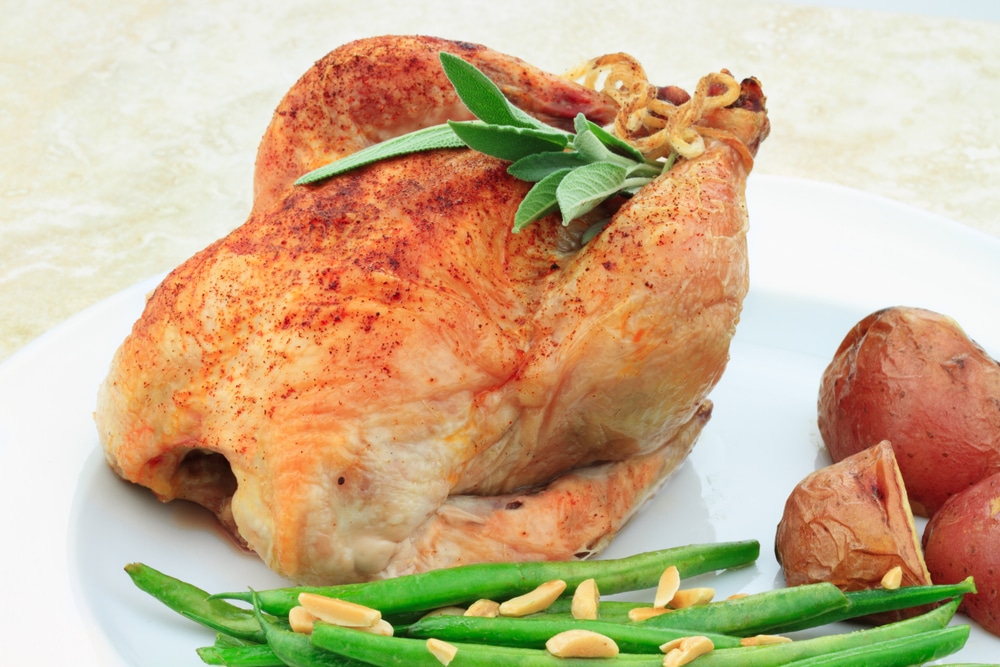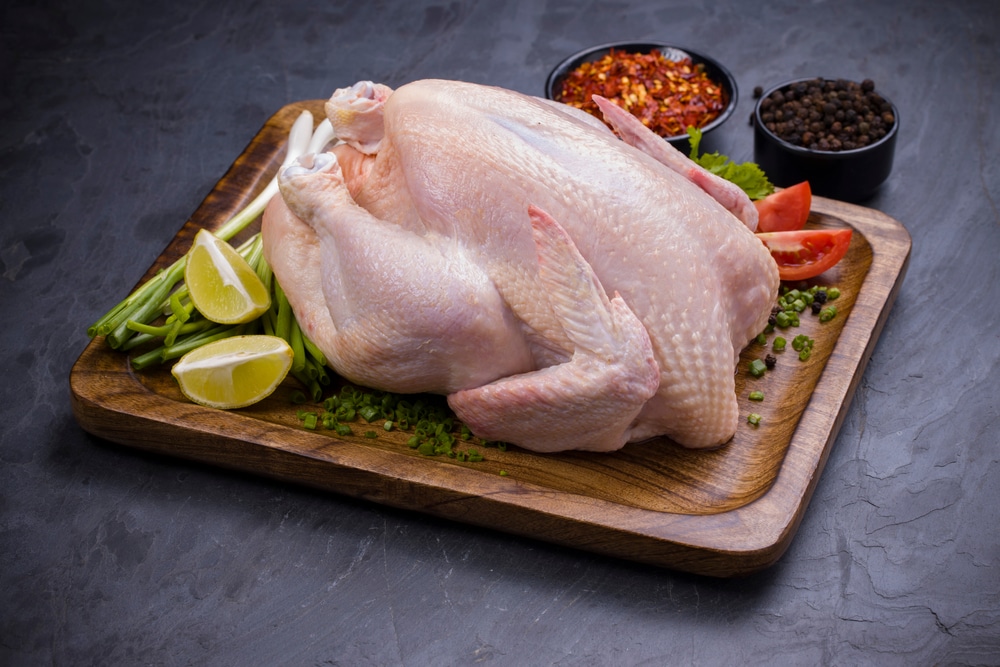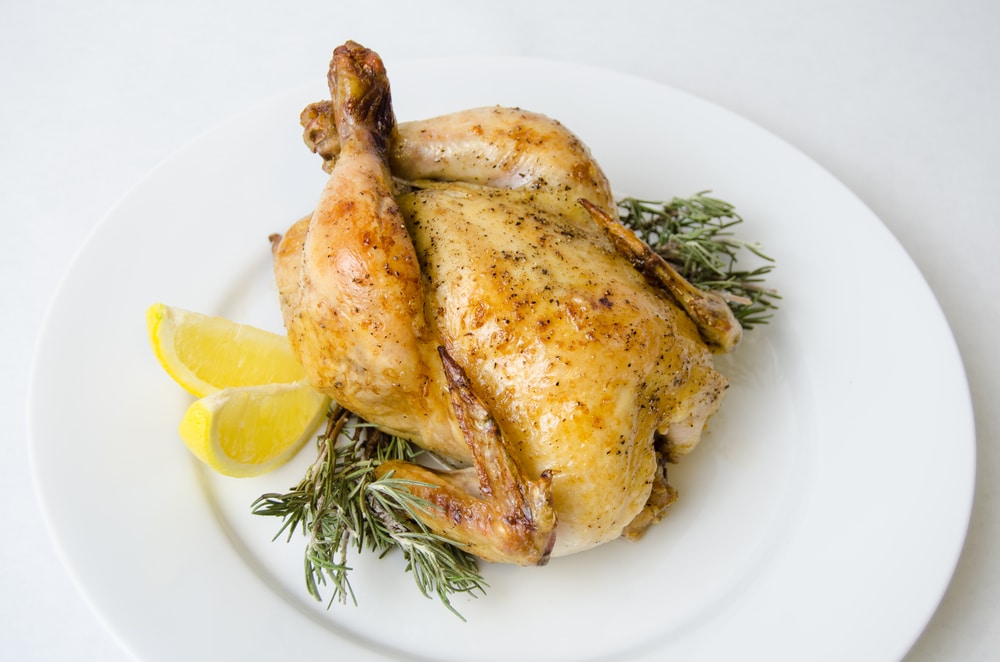Cornish hens are relatively new to the gourmet scene, with the original invention credited to as early as 1949. By the mid-1960s, Tyson Foods, the super-producer of poultry in America, began selling cornish hens. Now you can easily find cornish hens in any ordinary grocery store.
The main difference between cornish hen vs chicken is the size. A cornish hen is small enough to be a single serving for an elegant dinner party.
There are a few other variances to consider when deciding between cornish hen and chicken for your next dinner party or even a weeknight indulgence.

Consider these contrasts in size, price, taste, nutrition, versatility, and cooking style:
Size
A cornish hen is a chicken, just a much smaller version. Cornish hens are chickens harvested when they reach about one or two pounds, while you can expect whole roaster chicken to be between three to seven pounds when sold.
A chicken is a much larger size when sold whole in a grocery store or butcher shop. While a cornish hen will be harvested when they reach about five or six weeks of age, a chicken is considered full-grown for butchery at a comparatively ancient three to five months.
Typically, a cornish hen is sold to be cooked and served whole as an individual portion, while a whole chicken can be carved and served to a family.
Price
A cornish hen may command a price of between $2.50 and $5 per pound. However, you can purchase some varieties of factory-farmed chicken for as low as $0.99 per pound.
Cornish hens are very similar to the standard whole chicken you find in the meat department. While a cornish hen may sound like a sophisticated protein option that is not meant for the average home cook, think again.
For starters, these birds are often marketed as “cornish game hens”. This is a misnomer that leads to an artificially inflated price for this small version of chicken. These birds are not actually “game” birds, which might indicate they are exotic or wild animals.
In reality, cornish hens are simply a variety of chicken that has a good reputation.
Because of the tiny size of a cornish hen compared to a chicken, the price may come out to be very similar. However, a chicken has considerably more meat and versatility than a cornish hen. A cornish hen is a superior choice for an elegant, show-stopping presentation.

Taste
Cornish hens carry similarities to suckling pig or squab. Young meats are more tender and juicier than a chicken due to their small size. This compact size also makes it easier to absorb marinades and seasonings, giving this sometimes-bland protein a burst of flavor.
Some sellers deliver cornish hens with skin on, and others are skinless. Because cornish hen servings appear whole, we recommend purchasing one of these small hens with the skin. This choice improves moisture and flavor retention.
The New York Times offers this cornish hen recipe idea, imparting a Middle-Eastern flair to this small poultry. This featured recipe includes pomegranate and sumac to complement the tenderness and flavor of a cornish hen.
Nutrition
Because a cornish hen slaughtering occurs when it is so young, the bird contains much less fat overall. This strategy provides meat lower in fat than chicken and with fewer calories.
This very lean protein option has higher white meat than dark meat. White meat is beneficial to add niacin to your diet, while the nutrient riboflavin is abundant in dark portions.
Regardless of cornish hen vs chicken, poultry in general is high in protein. Protein helps build and develop strong muscles. Other vitamins in poultry include vitamin B, to prevent skin disease, heart conditions, and cataracts. Vitamin D promotes bone health and vitamin A also contributes to healthy eyes.
Versatility
When it comes down to cornish hen and chicken, versatility is a key component. As previously mentioned, a cornish hen is so small it can only be served whole, with bones. It would be too complicated and unnecessary to debone a cornish hen.
Because of this fact, a cornish hen would usually not be a good idea for use in a recipe, like for chicken tacos or a casserole. The higher price for a cornish hen also doesn’t make it logical to include in preparations other than as a whole bird.
In contrast, chicken is one of the most versatile proteins available. Every year, Americans eat about eight billion chickens. That amount is almost double the number eaten since the 1970s. Chicken can be served in so many preparations and for any cuisine. Home cooks prepare chicken in endless ways.
Cooking Style
As discussed above, chicken shines in virtually any cooking style. Grilled, roasted, braised, or sous vide, chicken is delicious in so many different ways. You can also debone chicken and shred it or serve a breast, leg, or thigh individually – unlike a cornish hen.
A cornish hen is only served in its complete state. An unorthodox meat option, a cornish hen is ordinarily presented as an individual serving. Because of the cornish hen’s lack of fat, it is important to cook these with care. Recommended cooking time is about an hour in a 425-degree oven.
Starting at about 45 minutes of cooking time, check the cornish hen every five minutes. It is a good idea to purchase a meat thermometer to monitor the cooking of a cornish hen. Watch for the peak 165 degrees Fahrenheit temperature to ensure it is safe to eat.
Comparison Table
| Cornish Hen | Chicken |
| Slaughtered at five to six weeks | Slaughtered at three to five months |
| Served whole, individual portion | Endless ways to serve can feed a family |
| Costs between $2.50 – $5 per pound | Can cost as low as $0.99 per pound |
Can you Substitute Cornish Hen for Chicken?
There are certain situations where you can substitute a cornish hen for chicken. When it comes to flavor, these two are virtually identical. If you consider a specific marinade or seasoning for your chicken, it will also be successful when applied to a cornish hen.
However, some recipes do not make sense for a cornish hen preparation. Mainly, these refer to the cooking style or serving of the poultry. If the recipe calls for a deboned chicken or the meat distributed into smaller, individual parts of the animal, chicken is the best choice.
For dinner party plans like a full roast chicken, consider substituting cornish hen for chicken. This will provide an elegant and head-turning centerpiece for every guest’s plate, as a whole small bird is presented. This substitution will result in spending more money, but it’s worth it!
What is a Cornish Hen?

A cornish hen is a small chicken, slaughtered when it is very young. The taste is virtually the same as chicken, but you may notice it is more tender and juicier than a standard chicken. A cornish hen is only served whole and will fetch a higher price for the seemingly fancy presentation.
How to use Cornish Hen
Cornish hen originated in the United States in the post-World War II era. After a devastating fire on a small Massachusetts farm wiped out its chickens, the farmers cross-bred the remaining flock and slaughtered them early. Thus, the cornish hen was born.
By the 1960s, cornish hens were widely available in the United States and around the world. Today, you can easily find cornish hen in the average grocery store. This poultry is also often referred to as a “cornish game hen”, although it is not a wild “game” bird.
Because of its seemingly fancy and exotic name, as well as the higher price, a cornish hen has a sophisticated reputation. However, you can serve them for an easy weeknight meal. The very tender, juicy, and flavorful meat is an indulgence accessible to anyone.
Cooks must cook cornish hen slowly and carefully, so as to not overcook such a small bird. Roasting with the classic combination of vegetables and potatoes is always a good option. This poultry option also absorbs marinades and seasonings well, so don’t be afraid to get creative!
What is Chicken?

Chicken is the ubiquitous protein option that remains one of the most popular meat options today. Chicken is prepared in a near-unlimited amount of ways. Fried chicken is a classic indulgence for many, while chicken street tacos have become a trendy sensation across the United States.
Chicken is affordable, with a flavor adaptable to many cuisines. While it can be served whole like a cornish hen, you can also break down the chicken into pieces. Some recipes may call for a boneless, skinless chicken breast – which are directions you will not find for a cornish hen.
How to use Chicken
Chicken is an ancient meat source, raised on homesteads for generations. Now, enormous factory farms produce billions of these birds for consumption internationally. Consider using chicken for any of your favorite recipes in a variety of cultures, from stir fry to pot pies.
You may also be interested in: Sesame chicken vs general tso







I’m obsessed with Cornish hens now, after a few bad experiences with regular chickens bought at my local grocery. Cornish hens have NO dark meat and almost no fat. The skin is very thin. I could not possibly eat a whole one at one sitting! I poach them to get all the meat off the bones and use the meat in recipes. I live alone and it may take me 3 or 4 days to use up all the meat from these little guys. When I separate the meat from the bones, I’m amazed at how many bones there are! But of course, because they are just small chickens! Same bones, just smaller. When I roasted them, I found it hard to get all the meat off the bones, so now I only poach gently, just under 2 hours, with salt, pepper corns, and a few bay leaves in the water for delicious broth which I drink or use in recipes. I find them LESS expensive per pound than the giant rubbery chickens in my local store, for some reason.
Hello Ivy and thanks for your experiences with cornish hens! They are such a nice item that don’t get much attention by most. Poaching is not a method that I’ve personally done much, so thanks for the inspiration. We’ve normally just roasted them in the oven or even pan-friend them (!) and they turn out incredible when the juices get caramelized on the think skin. The kids like to just eat (small) bones and all when we make it extra crispy on a pan. Delicious!